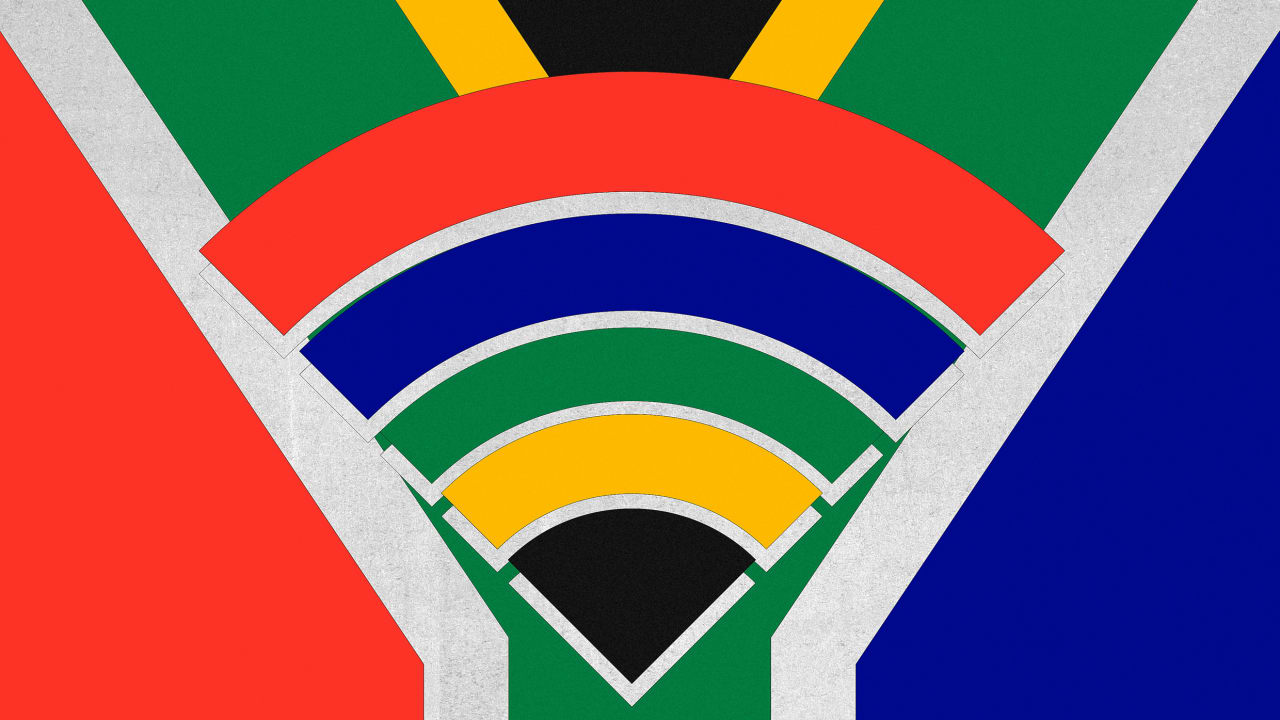South Africa wants to give every resident free broadband. Can it pull that off?
In August 2021, the government of South Africa made a radical promise: to hand out 10 free gigabytes of high-speed broadband to every household in its 60 million-plus population. Broadband and data will now become a basic utility that every household must receive, just like water and security, South Africa’s communications minister Khumbudzo Ntshavheni vowed. The country’s government hopes that providing the service will both boost connectivity and reduce the cost of internet access. “If this succeeds, South Africa will be Africa’s first broadband welfare state. It’ll be either a massive digital leap or flop,” says Denis Juru, president of the South Africa International Cross-Border Traders Association (SICTA), which lobbies for EU-like uniform taxes on telecom products imports across all southern Africa countries. It’s a turning point for the country that the World Bank has called the globe’s most unequal: Broadband has long symbolized South Africa’s alarming domestic wealth gulf, as 7.5 million low-income South Africans are paying 80 times more than middle- and upper-income residents to tap into the internet. Even after South Africa’s largest internet providers slashed prices by 50% in March 2020, due to a finding that data prices were some of the highest on the continent, the cheapest unlimited 4G broadband plan in the country still costs ZAR 479 ($30), a figure equal to nearly a month’s salary for millions of people who live at or below the poverty line. (In 2016, a vocal public campaign titled #DataMustFall broke out across the country, with citizens demanding that broadband prices be slashed.) While South Africa’s government has previously made similar promises to expand internet access, the current iteration of its plan appears more feasible—South Africa recently earned nearly a billion dollars from auctioning off 4G and 5G broadband radio spectrum, giving it the cash to implement the program, and is hoping Google’s planned subsea cable from Portugal to South Africa will help boost speeds. But as the government remains saddled with an archaic central planning system and corruption, some observers are skeptical about the prospect of broadband becoming a universal good in South Africa. “Being unable [to access] basic broadband is harsh: disconnection from real-time crime alerts, online job vacancies, digital education. It means our children waking up at 5 a.m. and walking hundreds of meters to ‘poach’ the fire station free internet signals and submit a desperate job CV online,” says Pela Xolile, leader of the Tembisa Better Streets Initiative, which advocates for free internet in poor townships of Tembisa, one of the biggest low-income townships in South Africa. “Free broadband in 2023 will be the biggest gift to us millions of poor South Africans—dwarfing the [ZAR350 ($23)] childcare grant we get from the state.” Anticipating universal broadband, the Independent Communications Authority of South Africa (ICASA), a state telecoms regulatory agency, has already started migrating all television and audio broadcasting in the country from analog to digital terrestrial. The process requires technical expertise and a large budget, and occurred in wealthier countries, like Canada, a decade ago. Roughly 572, 000 low-income households have already been transitioned to digital for free so far, and over the last decade, South Africa’s government has slowly started to provide some sort of free broadband to some residents. But those attempts to provide citizens with internet access have been dismal. South Africa’s Government Communication Information Systems, the roughly ZAR 500MN ($32 million) agency responsible for wiring free internet in township libraries, public hospitals, schools, and fire stations, has its hands full. The free community internet it currently offers is usually delivered via asymmetric digital subscriber line (ADSL), an older technology that transmits data over copper wire telephone lines, and is often slow. Disconnections are frequent because most community libraries, fire stations, schools, clinics, and halls are located far from exchanges, yet demand for connectivity in poor townships where millions live is heavy. “Technicians to monitor and repair free community internet are in shortage. The agency is a mess of its own,” says Xolile of the Tembisa Better Streets Initiative. It’s not just old infrastructure and slow speeds that prevents residents from accessing the internet. Communities also have to contend with municipalities failing to pay bills or theft of equipment. But the South African government feels its current plan is more sound than previous iterations. Because it plans to give free internet to households rather than public hospitals or schools, officials hope the strategy will reduce strain on the system and facilitate faster speeds. Most important, Google has also announced the expansion of its Equiano subsea internet cable, a key cog of the company’s $1 billion program to roll

In August 2021, the government of South Africa made a radical promise: to hand out 10 free gigabytes of high-speed broadband to every household in its 60 million-plus population. Broadband and data will now become a basic utility that every household must receive, just like water and security, South Africa’s communications minister Khumbudzo Ntshavheni vowed.
The country’s government hopes that providing the service will both boost connectivity and reduce the cost of internet access. “If this succeeds, South Africa will be Africa’s first broadband welfare state. It’ll be either a massive digital leap or flop,” says Denis Juru, president of the South Africa International Cross-Border Traders Association (SICTA), which lobbies for EU-like uniform taxes on telecom products imports across all southern Africa countries.
It’s a turning point for the country that the World Bank has called the globe’s most unequal: Broadband has long symbolized South Africa’s alarming domestic wealth gulf, as 7.5 million low-income South Africans are paying 80 times more than middle- and upper-income residents to tap into the internet. Even after South Africa’s largest internet providers slashed prices by 50% in March 2020, due to a finding that data prices were some of the highest on the continent, the cheapest unlimited 4G broadband plan in the country still costs ZAR 479 ($30), a figure equal to nearly a month’s salary for millions of people who live at or below the poverty line. (In 2016, a vocal public campaign titled #DataMustFall broke out across the country, with citizens demanding that broadband prices be slashed.)
While South Africa’s government has previously made similar promises to expand internet access, the current iteration of its plan appears more feasible—South Africa recently earned nearly a billion dollars from auctioning off 4G and 5G broadband radio spectrum, giving it the cash to implement the program, and is hoping Google’s planned subsea cable from Portugal to South Africa will help boost speeds. But as the government remains saddled with an archaic central planning system and corruption, some observers are skeptical about the prospect of broadband becoming a universal good in South Africa.
“Being unable [to access] basic broadband is harsh: disconnection from real-time crime alerts, online job vacancies, digital education. It means our children waking up at 5 a.m. and walking hundreds of meters to ‘poach’ the fire station free internet signals and submit a desperate job CV online,” says Pela Xolile, leader of the Tembisa Better Streets Initiative, which advocates for free internet in poor townships of Tembisa, one of the biggest low-income townships in South Africa. “Free broadband in 2023 will be the biggest gift to us millions of poor South Africans—dwarfing the [ZAR350 ($23)] childcare grant we get from the state.”
Anticipating universal broadband, the Independent Communications Authority of South Africa (ICASA), a state telecoms regulatory agency, has already started migrating all television and audio broadcasting in the country from analog to digital terrestrial. The process requires technical expertise and a large budget, and occurred in wealthier countries, like Canada, a decade ago. Roughly 572, 000 low-income households have already been transitioned to digital for free so far, and over the last decade, South Africa’s government has slowly started to provide some sort of free broadband to some residents.
But those attempts to provide citizens with internet access have been dismal.
South Africa’s Government Communication Information Systems, the roughly ZAR 500MN ($32 million) agency responsible for wiring free internet in township libraries, public hospitals, schools, and fire stations, has its hands full. The free community internet it currently offers is usually delivered via asymmetric digital subscriber line (ADSL), an older technology that transmits data over copper wire telephone lines, and is often slow. Disconnections are frequent because most community libraries, fire stations, schools, clinics, and halls are located far from exchanges, yet demand for connectivity in poor townships where millions live is heavy.
“Technicians to monitor and repair free community internet are in shortage. The agency is a mess of its own,” says Xolile of the Tembisa Better Streets Initiative. It’s not just old infrastructure and slow speeds that prevents residents from accessing the internet. Communities also have to contend with municipalities failing to pay bills or theft of equipment.
But the South African government feels its current plan is more sound than previous iterations. Because it plans to give free internet to households rather than public hospitals or schools, officials hope the strategy will reduce strain on the system and facilitate faster speeds. Most important, Google has also announced the expansion of its Equiano subsea internet cable, a key cog of the company’s $1 billion program to roll out a digital highway in Africa. It will land in South Africa later this year, and connect the country to Europe via Portugal, reportedly tripling internet speeds in South Africa.
For South Africa’s hard-pressed gig economy players, the so-called “broadband welfare” could revolutionize their respective industries. Ride share drivers, for example, hope that reducing what they spend on internet access will help boost their revenue.
“Data-connectivity costs slice off a chunk of our driver earnings,” says Darly Moyo, trade unionist and leader of the informal Uber-Bolt Drivers in South Africa Alliance, which claims to represent hundreds of drivers and took part in a ferocious nationwide strike in March. “The possibility to drive an Uber car on free broadband can boost drivers earnings by 2%. Free broadband is genius,” he tells Fast Company.
Still, some business executives say free basic broadband in South Africa could be expensive folly, because the urgent priority is to lay out fiber network extensively and make affordable data accessible. Unless the government gives subsidies to telecom corporations, some business leaders believe free broadband will saddle the middle class with higher broadband packages and taxes.
“Where is the fiber connection in rural areas where the majority of South Africans live? Who will pay the technicians? Who’ll audit the free data usage? Who’ll pay for the free 10 Gig skimmed off from private telecom corporations? This is utopia,” says Dennis Juru, president of SICTA. (South Africa’s government already owns a big broadband company, Telkom, so it has power to invest in better fiber connections and thus decrease data prices.)
Free basic internet broadband sounds revolutionary on paper, with the potential to reach millions of disconnected low-income South Africans. But knowing that South Africa’s government has run other basic national infrastructure—like railways and the electricity grid—into the ground, its vision of internet welfare appears flimsy. “You don’t move up a country into the 4th Industrial Revolution by data freebies,” says Juru.






















